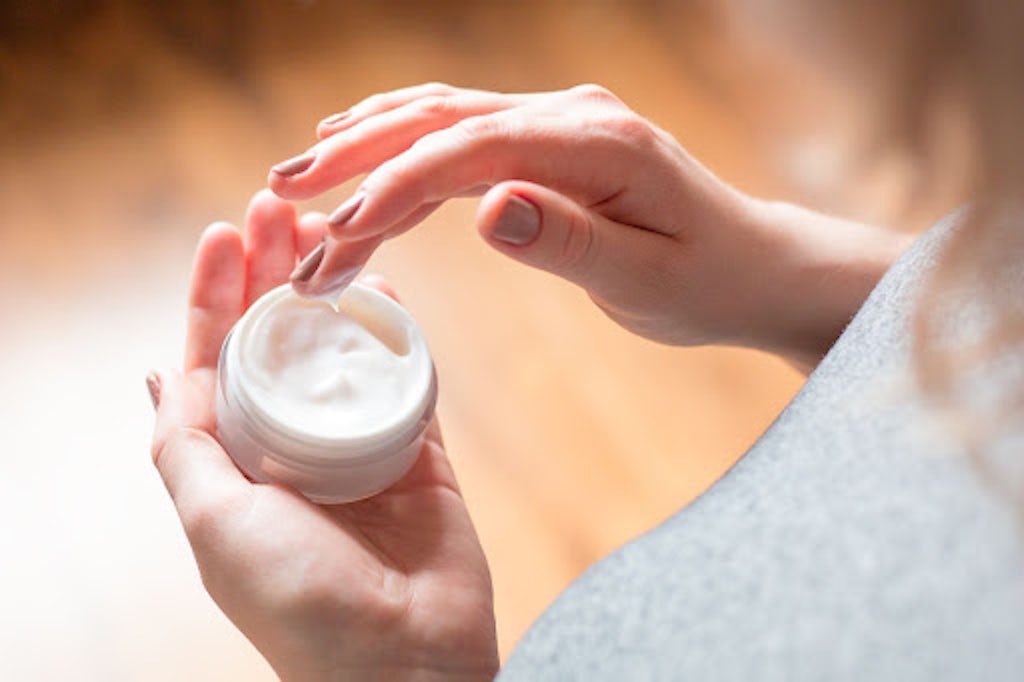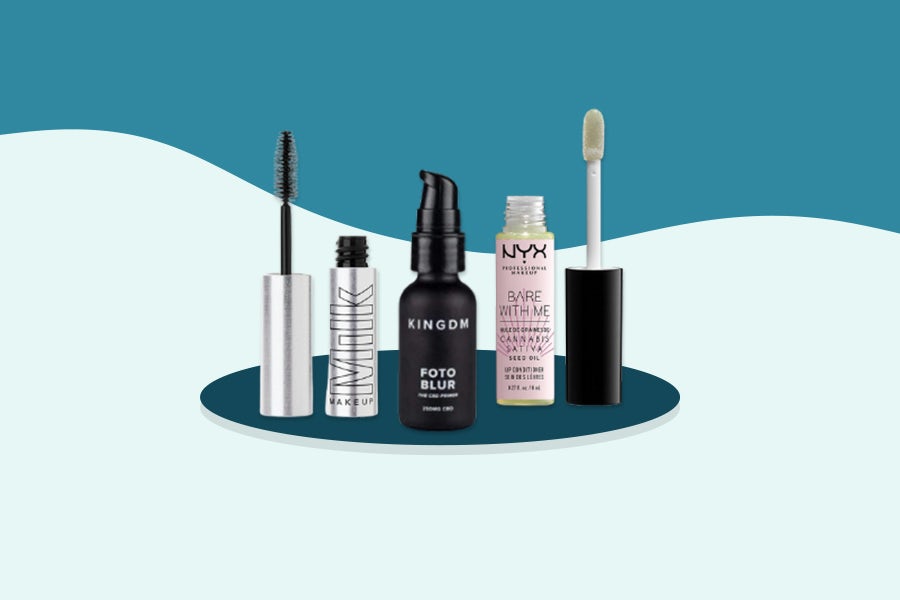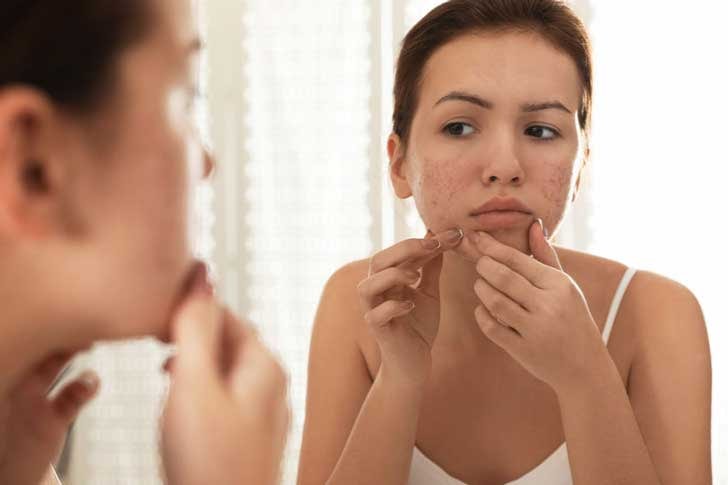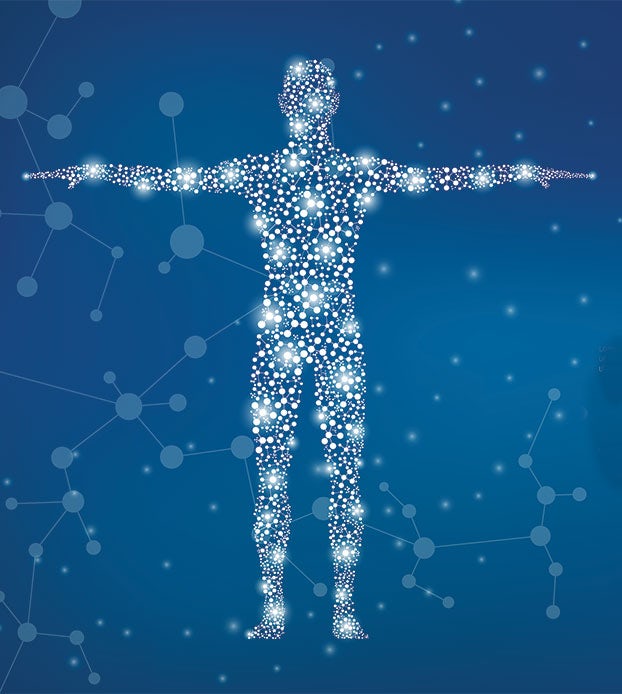Oils, creams, skin balms, gels and serums made from cannabis come in all shapes and sizes, and many of these products promise to improve your skin and make it healthier. But how does cannabis actually affect the skin?
Recent scientific studies suggest that different cannabinoids and other cannabis-derived molecules (e.g terpenes) may help treat a number of different skin conditions. Researchers are still in the early stages of learning how exactly cannabinoids affect skin health, but some of the results are compelling. 1
The endocannabinoid system’s role in skin health
The endocannabinoid system (ECS) is composed of receptors (locks) and their activating ligands (keys). The most common receptors in the ECS are CB1 and CB2, which are known to interact with cannabis derived cannabinoids, such as THC and CBD and with cannabinoids produced naturally in the body, known as endocannabinoids.
The different components of the ECS in the skin were Initially detected at Manuel Guzman lab during an anti-tumor study published in 2003. Since then, numerous studies have explored cannabinoid activity in the different skin layers. Scientists have noted ECS involvement in many biological activities of the skin, including, keratinocyte proliferation, sebum production, hair production, and inflammation. 2 3
Many non-CB1/CB2 receptors are also affected by the cannabinoids and terpenes and are also expressed in the various skin layers. Some of these have been identified as possible targets for the treatment of inflammatory skin conditions.
Can smoking weed cause premature aging of the skin?
Smoking tobacco cigarettes is commonly known to have the following effects:
- damage the skin
- premature aging
- damage collagen
- cause wrinkles
- lead to skin cancer
Cannabis smoke also contains some chemicals that are equally harmful to the skin, such as reactive oxygen species (ROS) or free radicals created by the high temperature of the burning and well known for damaging the skin.4 5
These free radicals are molecules, mainly oxygen, with unpaired electrons. The presence of unpaired electrons makes them highly unstable and reactive. Free radicals scavenge and attack other molecules and cells in the body and may damage proteins, lipids, and even our DNA. A primary cause of skin aging is caused by the presence of free radicals.
In contrast to tobacco, cannabis also contains many other compounds that have the potential to benefit the skin and reduce some of the harmful effects caused by the burning of derived free radicals and other chemicals in the smoke.

The development of novel cannabis consumption methods, including those that avoid burning and smoke related chemicals, will decrease harmful effects to the skin and enhance the positive effects of the cannabis compounds. These methods may include:
- regular consumption
- inhalation
- oral administration
- local treatment via topical products
If you consume cannabis as a spiff (mixed with tobacco), it’s worth considering avoiding the mix to reduce the significant risks to the skin related to tobacco and health in general. 6
Can cannabis make inflammatory skin conditions worse?
Inflammatory skin disorders are a group of conditions with diverse biological pathways and the involvement of many complex factors, but are often auto-immune in nature.
Skin disorders such as dermatitis, psoriasis and acne can all greatly affect a patient’s quality of life.
In 2019, a small study tested CBD ointment for its therapeutic potential within the skin, including patients with acne, dermatitis, and psoriasis. The results were very positive and showed the safety and effectiveness of the topical CBD.7
Common to many inflammatory conditions is the chronic activity of the immune system and elevated inflammatory signals, such as cytokines. Skin inflammation conditions are just as complex and involve an array of cells and molecules.
CBD and other cannabinoids have been shown to modulate the signals and severity of inflammation and could be useful in those with an overactive immune system. 8
While there is some conflicting evidence, the majority of studies suggest cannabinoid activity in skin inflammation conditions may contain a promising potential. The skin tissue (depending on the layer) is rich in CB1/CB2 and other non-cannabinoid receptors can be found in various cell types, including immune cells.
The prevalence of ECS components in the skin and related tissues highlight their importance in regulating inflammation and suggests that activation of ECS via phytocannabinoids could produce beneficial skin effects,
There are several studies that suggest CBD, THC, CBG and other less familiar cannabinoids can help with inflammatory skin conditions.
In one pre-clinical study, atopic dermatitis, an inflammatory skin disease, was treated with a synthetic cannabinoid topical emulsion and showed impressive results in both acute and chronic inflammation models. 9
But many more robust studies are needed to define the specific activity and benefits of various products and dosages for the treatment of inflammatory diseases.
Does cannabis cause acne or make it worse?
The vast majority of people have experienced acne in their life, more than 80% as teenagers. It is well known that many factors can influence the severity and prevalence of acne, such as hormones, diet and stress, some of them are connected to the ECS. 10
The interaction of cannabis with acne has quite limited medical data and there are few conflicting hypotheses. Sebum and oily, waxy substance naturally produced in the skin, and the main physiological factor in the development of acne. A human clinical study tested 3% cannabis seed extract (which is the healthy fats from the cannabis seeds and not rich in phytocannabinoids like CBD and THC) and determined significant improvement in cheek skin sebum, improving skin health and facial appearance. So these fatty acids even without CBD may be nourishing to the skin. 11
Another study described cannabidiol as an inhibitor of multiple factors related to acne and It describes CBD as having “potential as a promising therapeutic agent for the treatment of acne vulgaris.” 12
On the other hand, some evidence indicates that cannabis consumption may also worsen the severity of acne. One study examined male testosterone levels and found increased testosterone levels among cannabis users, and high testosterone is another main factor in acne development.The effect of cannabis on testosterone is still in question and needs further research. 13
Cannabis consumption may affect your behavior, appetite and diet, and general mood and all these factors might have direct or indirect effects on the severity of acne.
Other cannabis compounds, such as terpenes, may offer complimentary activity to cannabinoids, some demonstrating the inhibition of bacteria and inflammatory factors related to acne. 14
Can the antioxidant properties of some cannabinoids and terpenes help the skin?
Antioxidants are molecules that neutralize the free radicals, reducing or even preventing the oxidative damage to the tissues. The use of antioxidants in skin care was shown in several studies to have great value for skin general health by providing defense and reducing the damage caused by free radicals. Some examples of antioxidants are vitamin E, vitamin C, or other healthy plant molecules like lycopene (which makes tomatoes red) and resveratrol from red grapes and wine. 15

It was shown that CBD, THC as well as other cannabinoids, have antioxidative capacity. One study showed that CBD is superior to other famous antioxidants. Of course, cannabinoids are not alone, and some of the well-studied terpenes and also less studied flavonoids demonstrated their ability to be great antioxidant agents. Together with cannabinoids they might offer a synergistic antioxidant activity enhancing the benefits and rejuvenating skin tissue. 16 17
Is there a difference between topicals and other delivery methods?
Inhalation can provide systemic cannabinoid distribution in our body but little will end up in our skin tissues, as cannabinoids are primarily stored in fat cells. Cannabis topicals are “products that contain cannabis or cannabinoids and intended to be used only on external body surfaces.” Cannabinoids are fat-loving (“lipophilic”) molecules, making their permeability (or ability to pass through a barrier) to the skin quite limited in many of the existing topical products. Some studies found that several terpenes, such as geraniol may increase the skin permeability and absorption. The topical administration of cannabinoids may be improved through the use of new technologies and formulations which enhance absorption and specify the composition and dosage to specific clinical outcomes. 18
There is potential for cannabis to be used as a treatment for skin diseases such as acne, psoriasis and others. Cannabis and its constituents including the oils, cannabinoids, terpenes and flavonoids all have potential cosmetic uses as well, especially in context of its antioxidative activity. But in some cases, it may not be the correct choice for your condition, with responses ranging from minimal effect to worsening the condition.
As in many aspects of cannabis research, the need for determination of specific components, dosages, and delivery methods is great. Until we get more information it will remain difficult to recommend high quality, clinically proven, cannabis-based skin products.
Sources
- Eagleston LRM, Kalani NK, Patel RR, Flaten HK, Dunnick CA, Dellavalle RP. Cannabinoids in dermatology: a scoping review. Dermatol Online J. 2018 Jun 15;24(6):13030/qt7pn8c0sb. PMID: 30142706.
- Casanova ML, Blázquez C, Martínez-Palacio J, et al. Inhibition of skin tumor growth and angiogenesis in vivo by activation of cannabinoid receptors. J Clin Invest. 2003;111(1):43-50. doi:10.1172/JCI16116
- Sheriff T, Lin MJ, Dubin D, Khorasani H. The potential role of cannabinoids in dermatology. J Dermatolog Treat. 2020;31(8):839-845. doi:10.1080/09546634.2019.1675854
- Melamede R. Cannabis and tobacco smoke are not equally carcinogenic. Harm Reduct J. 2005;2:21. Published 2005 Oct 18. doi:10.1186/1477-7517-2-21
- Narendhirakannan RT, Hannah MA. Oxidative stress and skin cancer: an overview. Indian J Clin Biochem. 2013;28(2):110-115. doi:10.1007/s12291-012-0278-8
- Meier E, Hatsukami DK. A review of the additive health risk of cannabis and tobacco co-use. Drug Alcohol Depend. 2016;166:6-12. doi:10.1016/j.drugalcdep.2016.07.013
- Palmieri B, Laurino C, Vadalà M. A therapeutic effect of cbd-enriched ointment in inflammatory skin diseases and cutaneous scars. Clin Ter. 2019;170(2):e93-e99. doi:10.7417/CT.2019.2116
- Atalay S, Jarocka-Karpowicz I, Skrzydlewska E. Antioxidative and Anti-Inflammatory Properties of Cannabidiol. Antioxidants (Basel). 2019;9(1):21. Published 2019 Dec 25. doi:10.3390/antiox9010021
- Kim HJ, Kim B, Park BM, et al. Topical cannabinoid receptor 1 agonist attenuates the cutaneous inflammatory responses in oxazolone-induced atopic dermatitis model. Int J Dermatol. 2015;54(10):e401-e408. doi:10.1111/ijd.12841
- Marisa Taylor, Maria Gonzalez, Rebecca Porter. Pathways to inflammation: acne pathophysiology. European Journal of Dermatology. 2011;21(3):323-333. doi:10.1684/ejd.2011.1357
- Ali A, Akhtar N. The safety and efficacy of 3% Cannabis seeds extract cream for reduction of human cheek skin sebum and erythema content. Pak J Pharm Sci. 2015;28(4):1389-1395.
- Oláh A, Tóth BI, Borbíró I, et al. Cannabidiol exerts sebostatic and antiinflammatory effects on human sebocytes. J Clin Invest. 2014;124(9):3713-3724. doi:10.1172/JCI64628
- Thistle JE, Graubard BI, Braunlin M, et al. Marijuana use and serum testosterone concentrations among U.S. males. Andrology. 2017;5(4):732-738. doi:10.1111/andr.12358
- Russo EB. Taming THC: potential cannabis synergy and phytocannabinoid-terpenoid entourage effects. Br J Pharmacol. 2011;163(7):1344-1364. doi:10.1111/j.1476-5381.2011.01238.x
- Addor FAS. Antioxidants in dermatology. An Bras Dermatol. 2017;92(3):356-362. doi:10.1590/abd1806-4841.20175697
- Hampson AJ, Grimaldi M, Lolic M, Wink D, Rosenthal R, Axelrod J. Neuroprotective antioxidants from marijuana. Ann N Y Acad Sci. 2000;899:274-282.
- Isidore E, Karim H, Ioannou I. Extraction of Phenolic Compounds and Terpenes from Cannabis sativa L. By-Products: From Conventional to Intensified Processes. Antioxidants (Basel). 2021;10(6):942. Published 2021 Jun 10. doi:10.3390/antiox10060942
- Kigasawa K, Kajimoto K, Watanabe M, Kanamura K, Saito A, Kogure K. In vivo transdermal delivery of diclofenac by ion-exchange iontophoresis with geraniol. Biol Pharm Bull. 2009;32(4):684-687. doi:10.1248/bpb.32.684
Sign up for bi-weekly updates, packed full of cannabis education, recipes, and tips. Your inbox will love it.

 Shop
Shop Support
Support


















